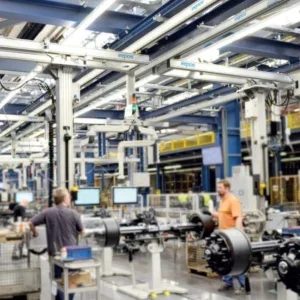
Suitable for a variety of purposes, hand operated chain hoists are frequently used as portable lifting appliances as well as permanent installations. Instructions from some manufacturers state that they are intended for vertical use only while others also allow for use at an angle. There are numerous applications where these hoists are used at an angle to the vertical, such as fleeting (travelling a load by transferring it from one block to another) and to provide adjustment within a slinging arrangement.
In practice this can be done safely within certain parameters provided appropriate precautions are taken: (a) only a hook suspended hoist should be used, (b) the suspension point must be suitable for the line of force and of adequate strength, (c) the hoist must be free to align between the seats of the top and bottom hooks, (d) it must be possible to operate the hand chain safely when the hoist is at the required angle(s).
It may, however, be contrary to the manufacturer’s instructions, so the user must either obtain the manufacturer’s or their representative’s permission in writing, or if they intend to use the hoists this way regardless, they are to be aware that they would take on the responsibility and risk of the manufacturer for use in this manner. In either case, they will need to carry out a risk assessment, draft a lift plan, and provide adequate instructions and a safe system of work for the application.
BRAKING AND ANCHORAGE
A hoist should be fitted with an automatic brake capable of arresting and sustaining the load. If the unit is intended to lift a very light load of 10% or less in relation to the chain hoist’s rated capacity, then the lift planner or end user should seek the advice of the manufacturer or supplier on the brake’s performance. This is because the brake relies upon the hoisting effort for its operation and with a very light load the effort available may be inadequate to operate the brake fully.
Some standards require the slack end anchorage for the load chain to be at least equal in strength to 2.5 times the maximum tension in the load chain when the Working Load Limit (WLL) is being lifted. While others also require the free end of the chain to be fitted with a chain end stop to prevent the chain passing completely through the hoist. This stop must also be able to withstand 2.5 times the tension in the chain when the WLL is being lifted.
These requirements are an important safety feature and should be considered as the minimum for hoists of all ages. If the user inadvertently runs the chain fully out and the slack end anchorage is not adequate, the chain will easily continue through the hoist and drop the load. It is therefore important to select hoists that have slack end anchorages or chain end stops.
LOAD CHAIN COLLECTING BOX
Where a hoist is fitted with a load chain collecting box, be mindful of a few things. First, given the chain is a load in itself, the uncontrolled fall of a length of chain could inflict serious injury upon any personnel in its path, in addition to subjecting the hoist to a high shock load. Using a manufacturer’s recommended load chain collecting box, which is properly designed for the job will help to mitigate this risk.
Secondly, the box should have adequate capacity for the entire load chain when the bottom hook is in the highest possible position – that is when the hoist is fully drawn up. If capacity is inadequate, the chain will spill over the edge and once this occurs, rather like a siphon, all the chain in the box will be pulled out at an accelerating rate.
Finally, if used where moisture or condensation is likely then the box should be provided with a suitable drainage hole to prevent a build-up of water.
SELECTING HOISTS
When selecting hand operated chain hoists, if documentation required by legislation is not on record, then refer the hoist to a Competent Person for thorough examination. Also, consider the length of load chain and hand chain required, the available headroom, the degree of portability required and the operating effort available (particularly for larger capacity hoists)
There are other types of hand operated lifting machines, which are designed for use in any orientation, for example lever hoists and jaw winches. Being lever operated, they are only suitable if the operative can be in a safe and ergonomically suitable position to operate the lever. However, where suitable they should be considered in preference to a hand chain hoist.
ABOUT LEEA
The Lifting Equipment Engineers Association (LEEA) is established across the globe as the leading representative body for all those involved in the lifting industry worldwide.
It is the respected and authoritative representative body for its members who work in every aspect of the industry, from design, manufacture, refurbishment and repair, through to the hire, maintenance and use of lifting equipment.
The Association has played a key role in this specialised field for over 80 years, from training and standards setting through to health and safety, the provision of technical and legal advice, and the development of examination and licensing systems.
LEEA represents its members at the highest levels across a range of both public and private bodies, including various government departments, as well as nationally and internationally recognised professional and technical institutions. www.leeaint.com @LEEA_INT






